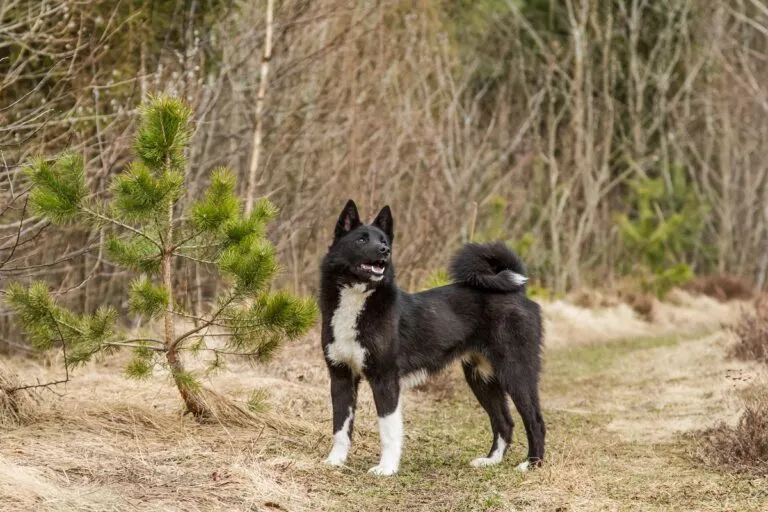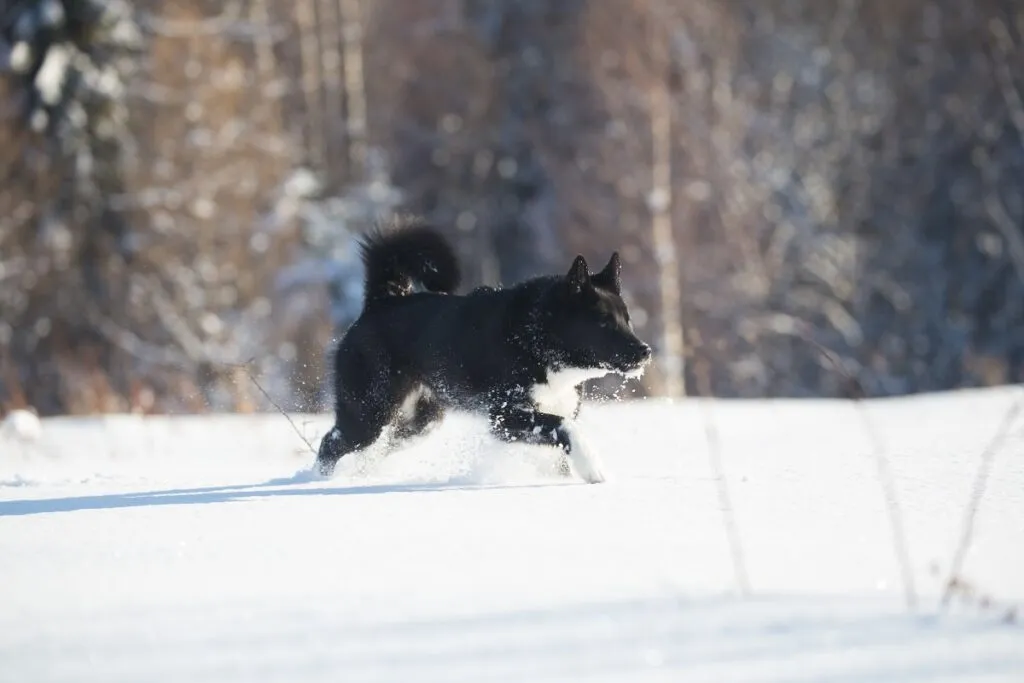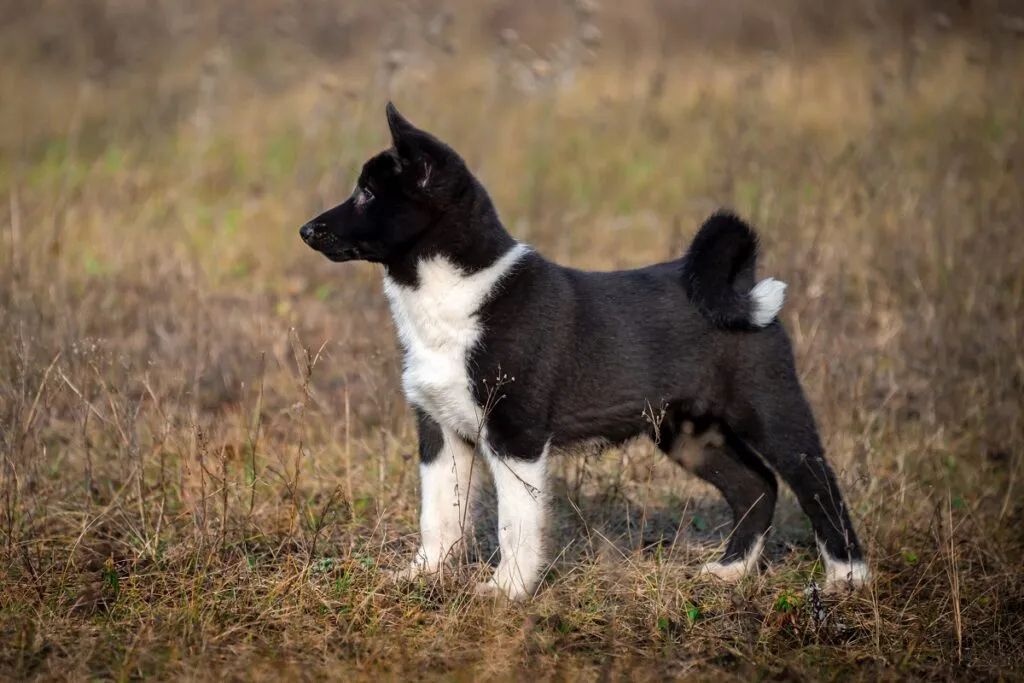Medium Size Poodle
The Russian-European Laika is a high-spirited hunting Spitz from the forest regions of European Russia. Brave and vocal, it will track and bark at both game such as elk and bears and smaller prey like squirrels and raccoons. When given ample stimulation, it becomes a friendly, child-loving companion within the family.

© ihorhvozdetskiy / stock.adobe.com
Black with white markings or white with black markings: that's the typical coat colour of the Russian-European Laika.
The Russian-European Laika is a medium-sized dog with a strong, square build. It belongs to the group of Spitz and primitive types of dog. Of all four recognised Laika breeds, the Russian-European Laika is the smallest.
Males reach a height at the withers of approx. 52 to 58 centimetres. Females are slightly smaller, at 48 to 54 centimetres. The weight for both genders is up to 25 kilograms.
Characteristically, the Russian-European Laika has a broad, wedge-shaped head, V-shaped erect ears, oval brown eyes, and a slender, muscular neck. Its tail is curled into a sickle or ring shape.
The coat of this Nordic breed is optimally adapted to the harsh weather conditions of its homeland. The Russian-European Laika has dense, hard, short to medium-length topcoat and plenty of undercoat. Around the neck, the coat forms a ruff, and in the face a beard.
The typical coat colours for this breed are black and white. Both single and bi-coloured dogs are common, while grey and brown individuals are rarer.
A red coat, as well as spots or dark ticking on the legs, are not desired traits in this breed.
 © ihorhvozdetskiy / stock.adobe.com
© ihorhvozdetskiy / stock.adobe.com
Originally, the Russian-European Laika was bred for hunting large game such as elk and bears. As a result, it has a strong hunting instinct, is highly active, and fearless. It’s a natural hunting assistant, displaying attributes such as endurance and independence.
The Russian-European Laika bonds closely with its owner. This hunting dog breed is only suitable as an amiable family dog when it is sufficiently exercised. If so, harmonious cohabitation with children is possible – by nature, this breed is not aggressive.
No visitor, or even uninvited guest, escapes the attention of this vigilant four-legged friend. This dog reacts sceptically to unknown people and unfamiliar dogs. The breed is territorial and extremely vocal, making it an excellent watchdog.
The Russian-European Laika requires plenty of exercise and thrives in natural environments. It is ideal if it can pursue its calling and track down wildlife.
Nowadays, these dogs are mainly used in the hunting of wild boar. The animals search for boars independently, circle them and bark at them.
If the lively Russian-European Laika is not kept for hunting purposes, it should be given other opportunities to let off steam and meet its high energy needs.
Dog sports such as Obedience or Agility are excellent choices. However, due to its strong hunting instinct, it should only be allowed off-leash in well-fenced areas.
It’s important that this breed is socialised well from puppyhood. The dogs need consistent, loving training and are best led by an active hunter. This hard-working hunting dog is not suited for novices.
Good to Know: A Russian-European Laika that is not sufficiently challenged will become bored, leading to behavioural issues.
Due to its tremendous energy, this Nordic hunting Spitz needs active, sporty owners who enjoy outdoor activities. A city apartment is not the right environment for a “chatty” dog like the Russian-European Laika. It is much better suited to a house with a garden where it can play the role of a guardian.
 © zoyas2222 / stock.adobe.com
© zoyas2222 / stock.adobe.com
When it comes to coat care, the Russian-European Laika is quite undemanding. Occasional brushing is generally more than enough. Only during the shedding periods in spring and autumn should owners reach for the brush more frequently.
Even regarding food, this rugged Russian chap is uncomplicated. It eats both wet and dry food and is well-suited to raw feeding. It’s essential to choose high-quality dog food and adjust portion sizes to the activity level of the animal.
The Russian-European Laika is considered a robust, healthy breed. Breed-specific diseases are not present. One of the reasons for this is the large gene pool breeders can draw from.
The breed is widespread from Finland, across the Kola Peninsula, to the Far East of Russia.
A well-exercised Russian-European Laika with a species-appropriate lifestyle and high-quality food can reach an advanced age.
The average life expectancy of this dog breed is around twelve years. However, some individuals live even longer.
The breed originates from the European forest regions of Russia and was first mentioned in writing in the late 19th century. It is closely related to the Karelian Bear Dog.
In addition, during its breeding history, elk and herding dogs have been crossed. The breeding criteria that distinguish this Laika from the East Siberian Laika and West Siberian Laika were first established in the Soviet Union in 1947 and confirmed in 1952.
The breed has been officially recognised by the international canine federation FCI since 1980.
Most Russian-European Laikas live in the northern Russian Taiga. Nevertheless, some have found their way to European countries, where they are valued as versatile and effective hunting dogs.
They track and bark at both large and smaller game such as squirrels, martens and raccoons. They also perform well in duck hunting
Outside of Russia, these dogs are quite rare. Anyone looking to buy a Russian-European Laika should contact a reputable breeder who is affiliated with an association. The price for a puppy of this breed costs no less than 1,400 pounds.
Since the Russian-European Laika is not very widespread outside its homeland, this breed is not commonly found in shelters. However, those who have fallen for this athletic hunting Spitz can still check out their local shelter.
The caretakers there know their charges well and can introduce potential owners to dogs with similar characteristics.
As a diligent, dutiful hunting assistant, the Russian-European Laika is a true asset during driven hunts. It is happiest when it can run freely, using its fine hearing and excellent nose.
Therefore, this enthusiastic working dog belongs in the hands of experienced, athletically active people.
| Special Features: | Hunting Spitz from the forest regions of European Russia, which tracks and barks at both large and small game. |
| Character: | enduring, independent, vigilant, intelligent |
| Height at the Withers: | Males52-58 cm, Females 48-54cm |
| Weight: | 20-25kg |
| Coat: | hard, dense, lots of undercoat, white base colour with black markings, or vice versa |
| Coat Care: | minimal effort |
| Exercise: | requires a lot of activity and enjoys movement |
| Suitable for Beginners: | no |
| Barking: | barks a lot |
| Life Expectancy: | 12 years |
| Typical Diseases: | robust breed, no known hereditary diseases |
| Price: | from £1,400 |
| FCI Group: | 5 “Spitz and primitive types of dog” |
| Exercise Needs: | high |
| Origin: | Russia |
Here are some purchase proposals curated by the zooplus editorial team
The products featured have been carefully selected by our editorial staff and are available at the zooplus online pet shop. The selection does not constitute advertising for the mentioned brands.
Fans of the Bearded Collie agree that those who aren't familiar with this dog breed simply have to get acquainted with it. And those who have experienced how a Bearded Collie bolts across meadows with its flowing fur, how it rolls around full of energy and joy and how it attentively and observantly takes into account its owners wishes become simply addicted to this original dog breed and its unique charm.
The Goldendoodle isn't a breed, but a pairing between Golden Retrievers and Medium or Standard Poodles. Marketed as a low-maintenance dog for allergy sufferers, this hybrid is enjoying increasing popularity amongst dog lovers, similar to the Labradoodle.